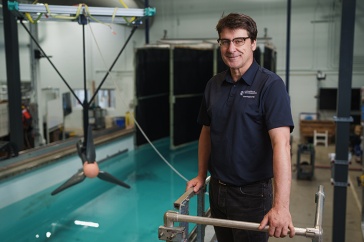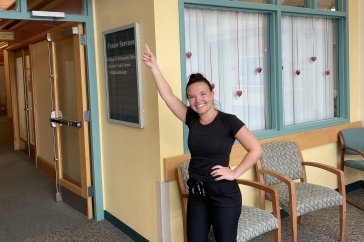
The Cardiac Rehab and Cardiac Prevention programs promote exercise and healthy lifestyle choices
The heart that gets broken, warmed, worn on sleeves, given away and occasionally left in San Francisco – the heart that symbolizes our deepest of emotions and is pressed into service in this, the most emotive of weeks – well, let’s face it, nobody knows the exact formula for keeping that heart healthy.
But the real heart, the fist-sized organ that pumps oxygen through your body with its incessant, rhythmic thump day after day after day–Melissa Rodgers knows just how to handle that one.
Rodgers is the director of the University of New Hampshire’s Cardiac Rehab and Cardiac Prevention programs, designed to help people get their hearts in shape through exercise and other lifestyle changes. She and her staff – a graduate student and six to eight undergraduate students who get class credit for their work – assist people who have had heart problems or who are at risk for heart problems.
“They come in and we do initial evaluations and run a whole regime of physical fitness tests,” said Rodgers, who has run the program for about four years. “And from that we develop an exercise program for them and note what things they might need to be educated on further.”
The two heart programs and a recently added peripheral artery program offer highly individualized routines with a common focus: hard work. “The best kind of exercise for the heart is cardiovascular, or aerobic, exercise,” Rodgers said. “Exercises like cycling, running swimming, that use large muscle groups and are performed at moderate intensity for an extended period of time.”
The 18-week programs are designed to bridge the gap between hospital cardiac rehab programs and independent diet and exercise regimes. And many times, that four-month fling turns into a lasting relationship. About 20 people are enrolled in the programs at any given time, but the majority are ongoing participants. “We have individuals who have been with us almost since the program started more than 30 years ago,” Rodgers said.
Why? Well, like true love, exercise and healthy eating just make people feel good. “People come back and they say, ‘I feel so much better,’” Rodgers said. “They feel more capable of achieving the normal activities of daily living without getting tired.”
And hey, when the old ticker is working well, it follows that the love life might get a boost too. The relationship between our real hearts and our symbolic hearts may, in fact, be reciprocal. Rodgers recently read a Michigan State University study that reaffirmed an idea that’s been kicking around for a while: people in long-lasting, happy relationships tend to live longer.
This being national Heart Health Month, Rodgers and her staff like to have a little fun with the analogy too. In years past they’ve handed out “valentines” with heart-health tips around campus, and this year they’re wearing red on Friday.
Just don’t come banging on her door with your love dilemmas.
For information on the Cardiac Rehabilitation and Prevention Programs, visit chhs.unh.edu/kin_es, call 862-0597 or e-mail melissa.rodgers@unh.edu.
Originally published by:
UNH Today
Written by Sarah Earle



















































